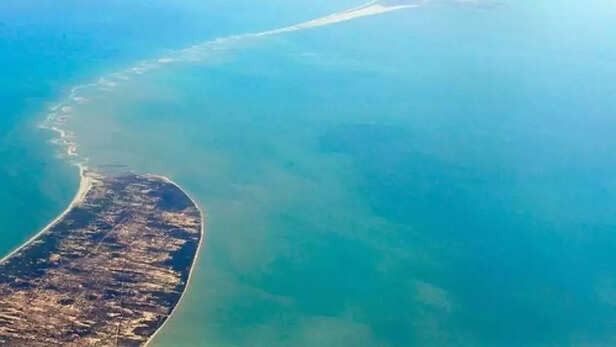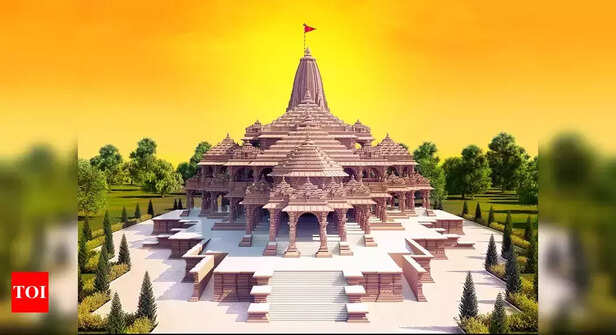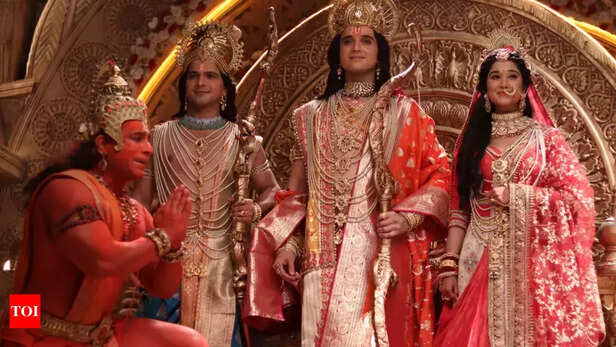8 Proofs Lord Rama Wasn’t Just a Myth
Riya Kumari | Jan 29, 2025, 12:45 IST
Lord Ram
The evidence supporting Lord Rama’s historicity is overwhelming. Astronomical calculations align perfectly with the Ramayana’s descriptions, geological findings confirm the existence of Ram Setu, and references in ancient texts and traditions further validate his presence. Far from being just a mythological figure, Lord Rama’s existence is a reality backed by scientific and historical research, proving that his story is deeply embedded in the fabric of our ancient civilization.
For centuries, Lord Rama has been revered as an incarnation of Vishnu and the ideal king. Yet, skeptics have often dismissed the Ramayana as mere mythology. However, modern scientific research, astronomical data, and archaeological discoveries suggest that Lord Rama’s existence is not just a matter of faith but also of historical and scientific significance. Here’s a closer look at the compelling proofs that establish Lord Rama as a historical figure.
1. Astronomical Dating of Lord Rama’s Life Events

The Valmiki Ramayana provides specific planetary positions at key moments in Lord Rama’s life. By using advanced planetarium software, researchers have calculated exact dates that align with these descriptions.
Lord Rama’s Birth - 5114 BC
According to Valmiki Ramayana (1/18/8-10), Lord Rama was born on the 9th tithi of Chaitra month during the daytime with the following planetary positions:
Sun in Aries
Saturn in Libra
Jupiter in Cancer
Venus in Pisces
Mars in Capricorn
Moon near Punarvasu star in Gemini
Lagna as Cancer
Planetarium software calculations place this celestial configuration on January 10, 5114 BC, suggesting a historical timeframe for Lord Rama’s birth.
Lord Rama’s Exile - 5089 BC
The Ramayana mentions that King Dashratha saw unfavorable planetary alignments (Sun, Mars, and Rahu in his nakshatra) before deciding to send Rama into exile. Astronomical calculations date this event to January 5, 5089 BC, indicating the age of 25 when Lord Rama left Ayodhya for his 14-year exile.
Key Events in Lord Rama’s Life
2. Archaeological and Geological Evidence

Ram Setu (Adam’s Bridge) – A Man-Made Structure?
The Ramayana describes a bridge built by Lord Rama’s army to cross into Lanka. Today, a chain of limestone shoals known as Adam’s Bridge or Ram Setu exists between Rameshwaram (India) and Mannar (Sri Lanka). NASA satellite images confirm the presence of this ancient bridge. Geological studies suggest that the bridge was above sea level around 7,000 years ago, indicating a viable land route during Lord Rama’s time. The top layer of the structure appears man-made, supporting the Ramayana’s description of a constructed bridge.
3. References in Ancient Texts Beyond the Ramayana

Lord Rama is not just mentioned in the Valmiki Ramayana but also in other ancient scriptures, reinforcing his historicity.
4. Historical and Cultural Impact

5. Genetic and Ancestral Lineage Evidence

6. Archaeological Evidence in Ayodhya and Lanka

Ayodhya Excavations
Lanka’s Connection to Ramayana
7. Linguistic and Cultural Continuity

The influence of Lord Rama’s story is not limited to India—it has spread across Southeast Asia, proving its historical significance.
8. Scientific Dating of Valmiki Ramayana

Linguistic studies suggest that the Sanskrit used in the Valmiki Ramayana is much older than previously assumed.
Researchers estimate that the language dates back to at least 5000 BC, aligning with the astronomical timeline.
The poetic structure and grammar are consistent with early Vedic Sanskrit, further supporting the idea that it is not a later fabrication but an authentic historical text.
1. Astronomical Dating of Lord Rama’s Life Events

Ram
( Image credit : Times Life Bureau )
The Valmiki Ramayana provides specific planetary positions at key moments in Lord Rama’s life. By using advanced planetarium software, researchers have calculated exact dates that align with these descriptions.
Lord Rama’s Birth - 5114 BC
Sun in Aries
Saturn in Libra
Jupiter in Cancer
Venus in Pisces
Mars in Capricorn
Moon near Punarvasu star in Gemini
Lagna as Cancer
Planetarium software calculations place this celestial configuration on January 10, 5114 BC, suggesting a historical timeframe for Lord Rama’s birth.
Lord Rama’s Exile - 5089 BC
Key Events in Lord Rama’s Life
- Battle with Khar-Dushan: A solar eclipse is mentioned in the Ramayana during this battle, aligning with an actual eclipse on October 7, 5077 BC.
- Killing of Bali: The Ramayana references another solar eclipse on the day Lord Rama killed Bali, which matches with April 3, 5076 BC.
- Hanuman’s Discovery of Sita: A lunar eclipse is noted when Hanuman saw Sita in Ashok Vatika, coinciding with a real lunar eclipse on September 12, 5076 BC.
- Defeat of Ravana: Planetary configurations suggest that Ravana was killed on December 4, 5076 BC.
- Return to Ayodhya: Lord Rama returned on January 2, 5075 BC, completing his 14-year exile.
2. Archaeological and Geological Evidence

Ram Setu
( Image credit : Times Life Bureau )
Ram Setu (Adam’s Bridge) – A Man-Made Structure?
The Ramayana describes a bridge built by Lord Rama’s army to cross into Lanka. Today, a chain of limestone shoals known as Adam’s Bridge or Ram Setu exists between Rameshwaram (India) and Mannar (Sri Lanka). NASA satellite images confirm the presence of this ancient bridge. Geological studies suggest that the bridge was above sea level around 7,000 years ago, indicating a viable land route during Lord Rama’s time. The top layer of the structure appears man-made, supporting the Ramayana’s description of a constructed bridge.
3. References in Ancient Texts Beyond the Ramayana

Mahabharat
( Image credit : Times Life Bureau )
Lord Rama is not just mentioned in the Valmiki Ramayana but also in other ancient scriptures, reinforcing his historicity.
- Mahabharata: Describes Lord Rama as an ancient king.
- Buddhist and Jain Texts: Acknowledge Lord Rama’s existence, with variations in the narrative.
- Srimad Bhagavata Purana, Adhyatma Ramayana, and Padma Purana: Detail Lord Rama’s life, exile, and rule.
4. Historical and Cultural Impact

Diwali
( Image credit : Times Life Bureau )
- Temples dedicated to Lord Rama exist across India, some dating back thousands of years, such as Ram Janmabhoomi in Ayodhya.
- Ancient sculptures and inscriptions mention Lord Rama, predating the supposed “mythological” era.
- The tradition of celebrating Diwali, marking Lord Rama’s return to Ayodhya, has continued for millennia, pointing to a deeply rooted historical basis.
5. Genetic and Ancestral Lineage Evidence

Shri Ram
( Image credit : Times Life Bureau )
- Recent genetic studies on ancient Indian populations indicate that a major migration and civilization shift occurred around 5000–7000 BC, which aligns with the era of Lord Rama.
- DNA studies show a continuous genetic lineage in Ayodhya, Mithila, and Kishkindha, suggesting these regions have been inhabited by the same lineage for thousands of years.
- The Ikshvaku dynasty, to which Lord Rama belonged, is referenced in multiple genealogical texts across different traditions, indicating real historical rulers.
- The Rigveda and other texts reference the Suryavanshi kings, a lineage that historical rulers like the Mauryas and Guptas later traced their ancestry to.
6. Archaeological Evidence in Ayodhya and Lanka

Ayodhya
Ayodhya Excavations
- The Ram Janmabhoomi site in Ayodhya has revealed temple structures beneath the Babri Masjid, dating back to 2000–3000 BC, suggesting an ancient shrine dedicated to Lord Rama existed there.
- Archaeologists have found pillars, inscriptions, and sculptures depicting Lord Rama’s life, confirming a long tradition of his worship in the region.
Lanka’s Connection to Ramayana
- Sri Lanka has sites that match the Ramayana’s descriptions, such as Ashok Vatika (believed to be near modern-day Nuwara Eliya).
- The Sigiriya Rock Fortress has underground tunnels resembling the ones described in Ravana’s palace.
- Archaeological evidence in Trincomalee and Mannar Island suggests ancient Hindu settlements, further reinforcing the story.
7. Linguistic and Cultural Continuity

Ramayana
( Image credit : Times Life Bureau )
The influence of Lord Rama’s story is not limited to India—it has spread across Southeast Asia, proving its historical significance.
- Thailand: The Thai royal family follows the Rama Dynasty, directly inspired by Lord Rama’s lineage. The capital was even named Ayutthaya (Ayodhya).
- Indonesia: The largest Hindu temple, Prambanan, is dedicated to Lord Rama, and the Ramayana is an integral part of Javanese and Balinese culture.
- Cambodia: The Angkor Wat temple, originally dedicated to Vishnu, depicts Ramayana stories in its carvings.
- China and Japan: The Ramayana has historical imprints in ancient Buddhist scriptures, referring to Lord Rama as a Bodhisattva.
8. Scientific Dating of Valmiki Ramayana

Valmiki Ramayana
( Image credit : Times Life Bureau )
Linguistic studies suggest that the Sanskrit used in the Valmiki Ramayana is much older than previously assumed.
Researchers estimate that the language dates back to at least 5000 BC, aligning with the astronomical timeline.
The poetic structure and grammar are consistent with early Vedic Sanskrit, further supporting the idea that it is not a later fabrication but an authentic historical text.
